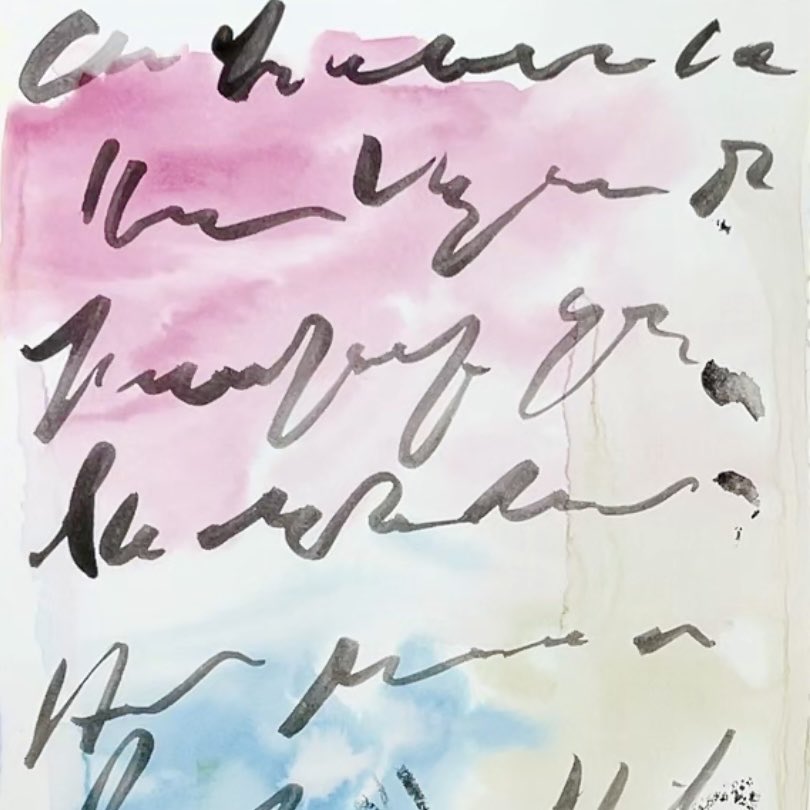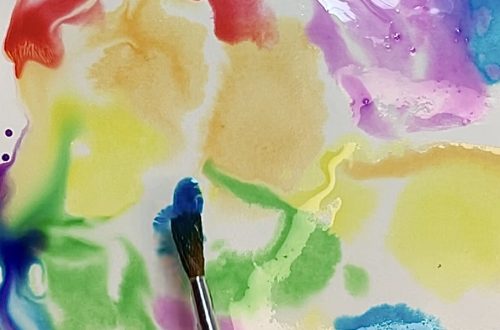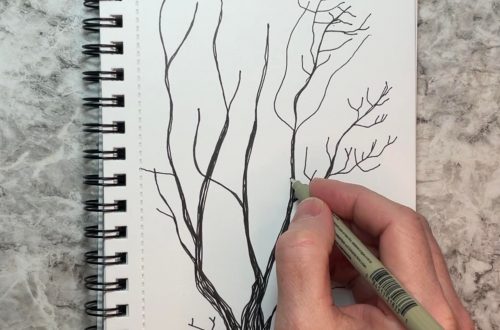
Week 30: Asemic Writing
Friends, I have been having so much fun learning and experimenting in Marabeth Quin’s Introduction to Collage: Learning to Paint with Paper. If you’ve been following my arty journey for a while, you may know I enjoy creating small art pieces with hand-painted cut paper. Using hand-painted tissue paper adds another dimension and opens new possibilities with its translucence. And the tissue-paper prep therapeutically relaxing.
Have you ever noticed the writing that isn’t writing in art? I never knew it had a name before I saw one of Marabeth’s YouTube videos on creating collage paper with tissue paper.
Asemic writing.
That’s what we’re going to play with this week.
You’ll need black acrylic paint, and maybe some blue, purple, green, or red, well any other color, if you’d like to add it to the black to get an interesting dark ink color. Just make sure you keep your pseudo ink close to black so it shows clearly, after we add our watercolor. Yes, as I mentioned wanting to last week, we’re getting back out the watercolors since I found out July is World Watercolor Month. But DO NOT use it for your ink.
You’ll need a relatively soft, small, round brush. I picked up some new inexpensive watercolor brushes on sale at Hobby Lobby recently. You’ll also need a brush, or brushes, of your choice of shape and size to apply your watercolor color.
And if you’re new here, Welcome! If you’d like to know more about what the 52-Week Art Journal Journey is, check out this introductory video, or the 52-Week Art Journal Journey tab above. Our first step on this journey was to make our journals, and this journey, our own. You can find the first prompt here.
The writing… that’s also the art
First mix a dab of black paint with some water. As mentioned, you can add another color. I used blue, but, as it turned out, not enough to make as noticeable a difference on this heavier paper.
A size 8 or 9 watercolor brush worked well on tissue paper for the asemic writing in the pieces you can at the beginning of the video, but they’re too big for our art journal pages. The first I tired, a 9, was too… blob. The 8 wasn’t much better. And, throughout, I struggled with a little too much “ink” on my brush with my first strokes. I might try less watered-down paint next time.
When I switched brushes again to write smaller, the first brush I tried was too uneven at the tip, so that didn’t work. It looked okay when I picked it up, but… yeah, no. Be sure to check the tip of your brush for any stray bristles.
For slightly smaller writing I ended up using a size 1. I was going to try the brush that came with my watercolor set, but couldn’t find it.
Use what you have, and enjoy the flow.
For me, asemic writing comes easiest when I’m thinking of words, but let my hand be as jumpy or undefined as it wants. It needs strong brush strokes, and to trickle off and away from the actual letters.
That’s the best I can explain it. You need to find what works, what flows, for you. That’s the key… allowing it to f l o w. When you get a feel for it, it’s kind of addictive, like the neurographic-ish Sharpie-line-softening I keep doing.
It’s relaxing. And distracting—in a good way. Quieting the noise in my brain.
Asemic writing is writing that has no literal meaning. It looks like there may be letters in it, but if you try to read them you find there’s nothing to read in the traditional sense. Any meaning is completely subjective. For me it feels, in process and how it works on my brain, like a hybrid of the line-making and -softening I mentioned, and my words upon words.
Click here for the neurographic lines of Week 25: Finding Peace in the Process.
And here’s the link to my favorite journaling/art process video from Week 4: Making Ugly Beautiful.
I can write what I’m thinking… without writing what I’m thinking…
Use what’s on your mind to start, as a springboard for your non-letters, -words, -sentences.
Write as much as you’d like. I ended up turning the page and continuing a few times.
And, after your writing is dry, which doesn’t take long. Break out the watercolors and get lost in those for a while, too. This is where the difference between acrylics and watercolors is important. The acrylic paint won’t bleed or run when you go over it with water.
As I say every week, have fun with it. Don’t think too much about the writing; just do it. And enjoy watercolor play however you’re feeling it.
Thanks for taking the time for creative self-care. I’m happy for you! And appreciate the opportunity to remind you that art isn’t a waste of time, and encourage you to exercise your creativity. It’s important to your mental and emotional and spiritual health.
I’ll be back next week with another small-art and journaling prompt. In the meantime, enjoy expressing yourself with asemic writing, and watercolor painting as creatively as you’d like. You can also check out or revisit past prompt videos by clicking here, or written ones via the tab above.
If you’d like an extra bit of weekly creative self-care encouragement in your inbox, sign up here. If you haven’t yet, I’d love to have you join me on Facebook or Instagram. If you decide to share any of your small art on Instagram to encourage others to take time for creative self-care, tag me @melindavanry (I’m @melindavanrydesign on Facebook), and use #artjournalwithmelinda. I’d love to see what you’re creating! If you’d like to share, be encouraged, and encourage in a safe supportive community, email subscribers are invited to join the new and slowly growing private Art Journal Journey Facebook group. If you have art to share, I’d love to see you there.




